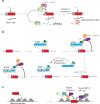Hide and seek: how chromatin-based pathways silence retroelements in the mammalian germline
- PMID: 26821364
- PMCID: PMC4914476
- DOI: 10.1016/j.gde.2015.12.001
Hide and seek: how chromatin-based pathways silence retroelements in the mammalian germline
Abstract
Retroelements comprise a major fraction of most mammalian genomes. To protect their fitness and stability, hosts must keep retroelements in check in their germline. In most tissues mobile element insertions are decorated with chromatin modifications suggestive of transcriptional silencing. However, germline cells undergo massive chromatin reprogramming events, which erase repressive chromatin marks and necessitate de novo re-establishment of silencing. How do host genomes achieve the discrimination necessary for this de novo silencing? A series of recent studies have revealed aspects of the multi-pronged strategy that mammalian genomes use to identify and silence retroelements. These strategies include the use of small RNA-guides, of specialized DNA-binding protein adaptors and of proteins that repair chromatin discontinuities caused by retroelement insertions. Genetic analyses reveal the importance of these mechanisms of protection, each of which specializes in silencing retroelements of different evolutionary ages. Together, these strategies allow mammalian genomes to withstand the high burden of their parasites.
Copyright © 2015 Elsevier Ltd. All rights reserved.
Figures

References
-
- Reik W, Dean W, Walter J. Epigenetic reprogramming in mammalian development. Science. 2001;293:1089–1093. - PubMed
-
- Surani MA, Hayashi K, Hajkova P. Genetic and epigenetic regulators of pluripotency. Cell. 2007;128:747–762. - PubMed
-
- Kigami D, Minami N, Takayama H, Imai H. MuERV-L is one of the earliest transcribed genes in mouse one-cell embryos. Biol Reprod. 2003;68:651–654. - PubMed
Publication types
MeSH terms
Substances
Grants and funding
LinkOut - more resources
Full Text Sources
Other Literature Sources

